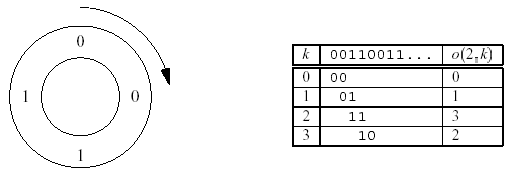POJ - 1392 Ouroboros Snake (欧拉回路的应用)
2014-08-09 10:27
375 查看
Description
Ouroboros is a mythical snake from ancient Egypt. It has its tail in its mouth and continously devours itself.
The Ouroboros numbers are binary numbers of 2^n bits that have the property of "generating" the whole set of numbers from 0 to 2^n - 1. The generation works as follows: given an Ouroboros number, we place its 2^n bits wrapped in a circle. Then, we can take
2^n groups of n bits starting each time with the next bit in the circle. Such circles are called Ouroboros circles for the number n. We will work only with the smallest
Ouroboros number for each n.
Example: for n = 2, there are only four Ouroboros numbers. These are 0011;0110;1100; and 1001. In this case, the smallest one is 0011. Here is the Ouroboros circle for 0011:

The table describes the function o(n;k) which calculates the k-th number in the Ouroboros circle of the smallest Ouroboros number of size n. This function is what your program should compute.
Input
The input consists of several test cases. For each test case, there will be a line containing two integers n and k (1<=n<=15; 0<=k<2^n). The end of the input file is indicated by a line containing two zeros. Don抰 process that line.
Output
For each test case, output o(n;k) on a line by itself.
Sample Input
Sample Output
题意:让你找个字典序最小的序列使得排成环旋转后取n个,最后可以取到[0-2^n)的所有数。
思路:欧拉回路的应用,首先为了找最短,所有我们希望这个数的后n-1位和下一个数的前n-1位是相同的,只有他们的头和尾不一样,所以我们有每添加一位就可以构成一个新的数,那么这两个数就能通过这位来连接,我们可以先枚举出所有的节点,然后对应产生边,我们最后要跑完所有的边且回到原点,而这就是欧拉回路了
Ouroboros is a mythical snake from ancient Egypt. It has its tail in its mouth and continously devours itself.
The Ouroboros numbers are binary numbers of 2^n bits that have the property of "generating" the whole set of numbers from 0 to 2^n - 1. The generation works as follows: given an Ouroboros number, we place its 2^n bits wrapped in a circle. Then, we can take
2^n groups of n bits starting each time with the next bit in the circle. Such circles are called Ouroboros circles for the number n. We will work only with the smallest
Ouroboros number for each n.
Example: for n = 2, there are only four Ouroboros numbers. These are 0011;0110;1100; and 1001. In this case, the smallest one is 0011. Here is the Ouroboros circle for 0011:

The table describes the function o(n;k) which calculates the k-th number in the Ouroboros circle of the smallest Ouroboros number of size n. This function is what your program should compute.
Input
The input consists of several test cases. For each test case, there will be a line containing two integers n and k (1<=n<=15; 0<=k<2^n). The end of the input file is indicated by a line containing two zeros. Don抰 process that line.
Output
For each test case, output o(n;k) on a line by itself.
Sample Input
2 0 2 1 2 2 2 3 0 0
Sample Output
0 1 3 2
题意:让你找个字典序最小的序列使得排成环旋转后取n个,最后可以取到[0-2^n)的所有数。
思路:欧拉回路的应用,首先为了找最短,所有我们希望这个数的后n-1位和下一个数的前n-1位是相同的,只有他们的头和尾不一样,所以我们有每添加一位就可以构成一个新的数,那么这两个数就能通过这位来连接,我们可以先枚举出所有的节点,然后对应产生边,我们最后要跑完所有的边且回到原点,而这就是欧拉回路了
#include <iostream>
#include <cstring>
#include <algorithm>
#include <cstdio>
#include <vector>
using namespace std;
const int maxn = 1<<16;
struct Edge {
int v, via;
int vis;
};
vector<Edge> ve[maxn];
int path[maxn<<1];
int n, k, cnt;
void init() {
for (int i = 0; i < maxn; i++)
ve[i].clear();
}
void dfs(int cur) {
for (int i = 0; i < ve[cur].size(); i++)
if (!ve[cur][i].vis) {
ve[cur][i].vis = 1;
dfs(ve[cur][i].v);
path[++cnt] = ve[cur][i].via + '0';
}
return;
}
int main() {
while (scanf("%d%d", &n, &k) != EOF && n+k) {
int len = n;
n = (1<<(n-1)) - 1;
init();
Edge tmp;
for (int i = 0; i <= n; i++) {
int t = (i<<1) - ((i&(1<<(len-2)))<<1);
tmp.v = t;
tmp.via = 0;
tmp.vis = 0;
ve[i].push_back(tmp);
t += 1;
tmp.v = t;
tmp.via = 1;
tmp.vis = 0;
ve[i].push_back(tmp);
}
cnt = -1;
dfs(n);
path[++cnt] = '\0';
reverse(path, path+cnt);
int ans = 0;
for (int i = k, j = 1; j <= len; j++, i++)
ans = (ans<<1) + (path[i%cnt]-'0');
printf("%d\n", ans);
}
return 0;
}
相关文章推荐
- 欧拉回路 poj-1392 Ouroboros Snake
- 欧拉回路 poj-1392 Ouroboros Snake
- poj 2230 Watchcow (欧拉回路的应用)
- POJ-1392-Ouroboros Snake
- POJ 1392 欧拉回路
- poj 1392 Ouroboros Snake
- POJ-1392 Ouroboros Snake
- POJ 1392 Ouroboros Snake 欧拉回路
- poj 1780 , poj 1392 欧拉回路求前后相互衔接的数字串
- poj1300doorman欧拉回路简单应用
- poj 1637 (浅谈最大流在解决混合图欧拉回路中的应用)
- POJ 1392 - Ouroboros Snake 求0011这类序列欧拉回路的最小路径...
- POJ 1392 Ouroboros Snake (欧拉回路)
- POJ-1392 Ouroboros Snake 欧拉回路
- POJ 1392 Ouroboros Snake
- poj 1392 Ouroboros Snake
- zoj 1130 poj 1392 Ouroboros Snake (欧拉路径)
- POJ 3615 牛的最小最大起跳高度问题 Floyd算法的变形应用
- POJ 1828 选猴王 排序qsort应用
- stack应用 POJ 2929&3704 括号匹配
